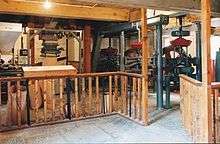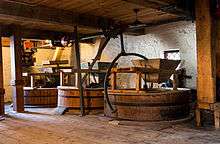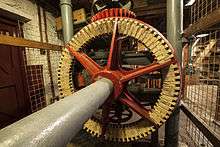Cavan Water Mill
Cavan Water Mill, formerly Lifeforce Mill, is a 19th-century mill located in Cavan. The current building dates from 1846 and contains a notable MacAdam water turbine. Having been abandoned in the 1960s, it was restored as a museum and visitor attraction in the 1990s.[1]

History of the site

Milling on this site can be traced back to the 14th century, when there was a Franciscan mill in the same location.[1]
The current mill was established by the Greene family in 1846.[2] During the 1840s, there were 90 working water mills in County Cavan, but at the time this mill was built it was the only one within a two-mile radius.[1]
The building operated as a mill for more than a century until its closure in the 1960s. Following restoration, it operated again for a short while as a working mill for the creation of wholemeal flour for Lifeforce Foods.[2]
Design of the building
The two-storey design has a three-bay extension at split level to the west and a two-storey return to the side. An adjacent mill building to the north was removed from its original site and rebuilt here in 1995 as part of the mill's restoration.[3] As the only surviving example of one of the five mills that stood in Cavan Town, it is listed on the National Inventory of Architectural Heritage for Ireland.[3]
MacAdam Turbine

Cavan Water Mill operates a MacAdam turbine as opposed to a conventional water wheel. The turbine was described as one of the few, if not the only surviving MacAdam turbines in Ulster in 1983.[4] The turbine may be an example of 19th-century industrial espionage, as it is believed to be a patent infringing copy of a design by Benoît Fourneyron.[2] A similar turbine was installed at Ballincollig Royal Gunpowder Mills, Cork in 1853.[2]
References
- "Green Mill or the Life Force Mill". cavanwalkinghistory.ie. Cavan Walking History. Retrieved 24 May 2015.
- Mulvihill, Mary (2002). Ingenious Ireland. Dublin: TownHouse and CountryHouse Ltd. p. 226. ISBN 1860591450. Retrieved 24 May 2015.
- "Main Record – County Cavan". buildingsofireland.ie. National Inventory of Architectural Heritage. Retrieved 24 May 2015.
- Anglo Celt, Professor Alan Crocker. Retrieved from http://www.anglocelt.ie/photostore/image-31352